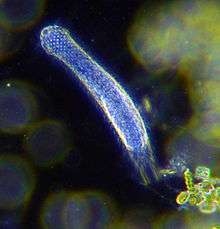Eutely
Eutelic organisms have a fixed number of somatic cells when they reach maturity, the exact number being constant for any one species. Development proceeds by cell division until maturity; further growth occurs via cell enlargement only. In nematodes the number of nuclei is also constant; there is growth in size of the body but this is due to the growth in the size of the cells (hypertrophy).

A mature gastrotrich, with visible cells on the surface. Further growth will now occur solely by cell enlargement.
Most eutelic organisms are microscopic. Examples include the rotifers, ascaris, many species of nematodes (including the model organism Caenorhabditis elegans whose male individuals have 1031 cells[1]), tardigrades, larvacea and dicyemida.[2][3]
External links
References
- Ruppert, Edward E.; Fox, Richard, S.; Barnes, Robert D. (2004). Invertebrate Zoology (7th ed.). Cengage Learning. p. 753. ISBN 978-81-315-0104-7.
- "How many cells are there in an organism?" (PDF). Archived from the original (PDF) on 2016-03-10. Retrieved 2016-02-29.
- "Miscellaneous characters - Contributions to Zoology". Archived from the original on 2016-10-06. Retrieved 2016-02-29.
This article is issued from Wikipedia. The text is licensed under Creative Commons - Attribution - Sharealike. Additional terms may apply for the media files.